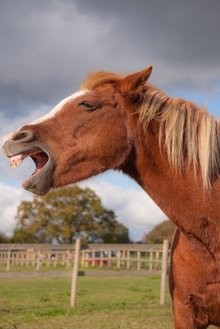Scientists at the Zurichâs Federal Institute of Technology ETHZ have identified two different frequencies in a horseâs whinny that can indicate emotional state and level of excitement. This could help in providing better care.

Decoding horse whinnies
Researchers were able to associate positive emotions with short horse whinnies in which the higher frequency was lower, accompanied by a lowering of the head, but when expressing negative emotions the whinnies were longer and the higher frequency was higher.
Whinnies are the longest, loudest and most common horse communication and are composed of three parts: introduction, climax and end. But until now, it was not known that horses could whinny in two âvoicesâ.
âOne frequency indicates whether the emotion is positive or negative, while the other frequency reveals the strength of the emotion,â says project leader Elodie Briefer, of ETHZâs Ethology and Animal Welfare Unit.
The researchers were able to associate positive emotions with short whinnies in which the higher frequency was lower, accompanied by a lowering of the head. When expressing negative emotions the whinnies were longer and the higher frequency was higher.
Scientists do not yet know how horses produce such complex sounds simultaneously. They suspect that the two different frequencies are a result of an âasynchronous vibration pattern of the vocal cordsâ.
The research team analysed 267 whinnies collected from 18 different horses to arrive at the conclusion. Cameras and microphones were used to capture horse behaviour and sounds. Physiological responses, such as heart rate, breathing and skin temperature were also recorded. To correlate the sounds and behaviour produced with positive or negative emotions, the horses were separated or united with their herd.
About the horse whinny research
Studying vocal correlates of emotions is important to provide a better understanding of the evolution of emotion expression through cross-species comparisons. Emotions are composed of two main dimensions: emotional arousal (calm versus excited) and valence (negative versus positive).
These two dimensions could be encoded in different vocal parameters (segregation of information) or in the same parameters, inducing a trade-off between cues indicating emotional arousal and valence.
We investigated these two hypotheses in horses. We placed horses in five situations eliciting several arousal levels and positive as well as negative valence. Physiological and behavioral measures collected during the tests suggested the presence of different underlying emotions.
First, using detailed vocal analyses, we discovered that all whinnies contained two fundamental frequencies (âF0â and âG0â), which were not harmonically related, suggesting biphonation. Second, we found that F0 and the energy spectrum encoded arousal, while G0 and whinny duration encoded valence.
Our results show that cues to emotional arousal and valence are segregated in different, relatively independent parameters of horse whinnies. Most of the emotion-related changes to vocalizations that we observed are similar to those observed in humans and other species, suggesting that vocal expression of emotions has been conserved throughout evolution.
The researchers expect that the results of the study will help horse owners and veterinarians respond better to horsesâ needs.
